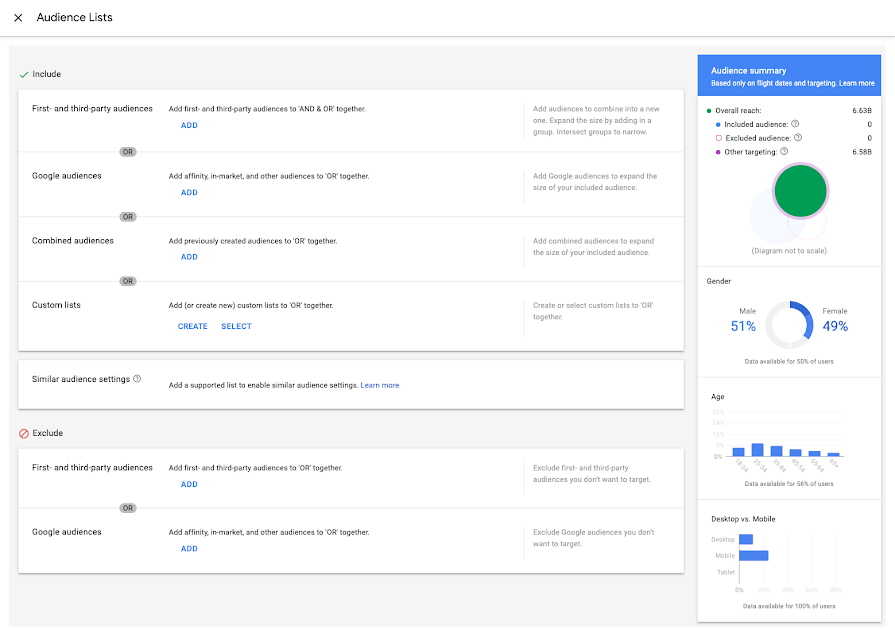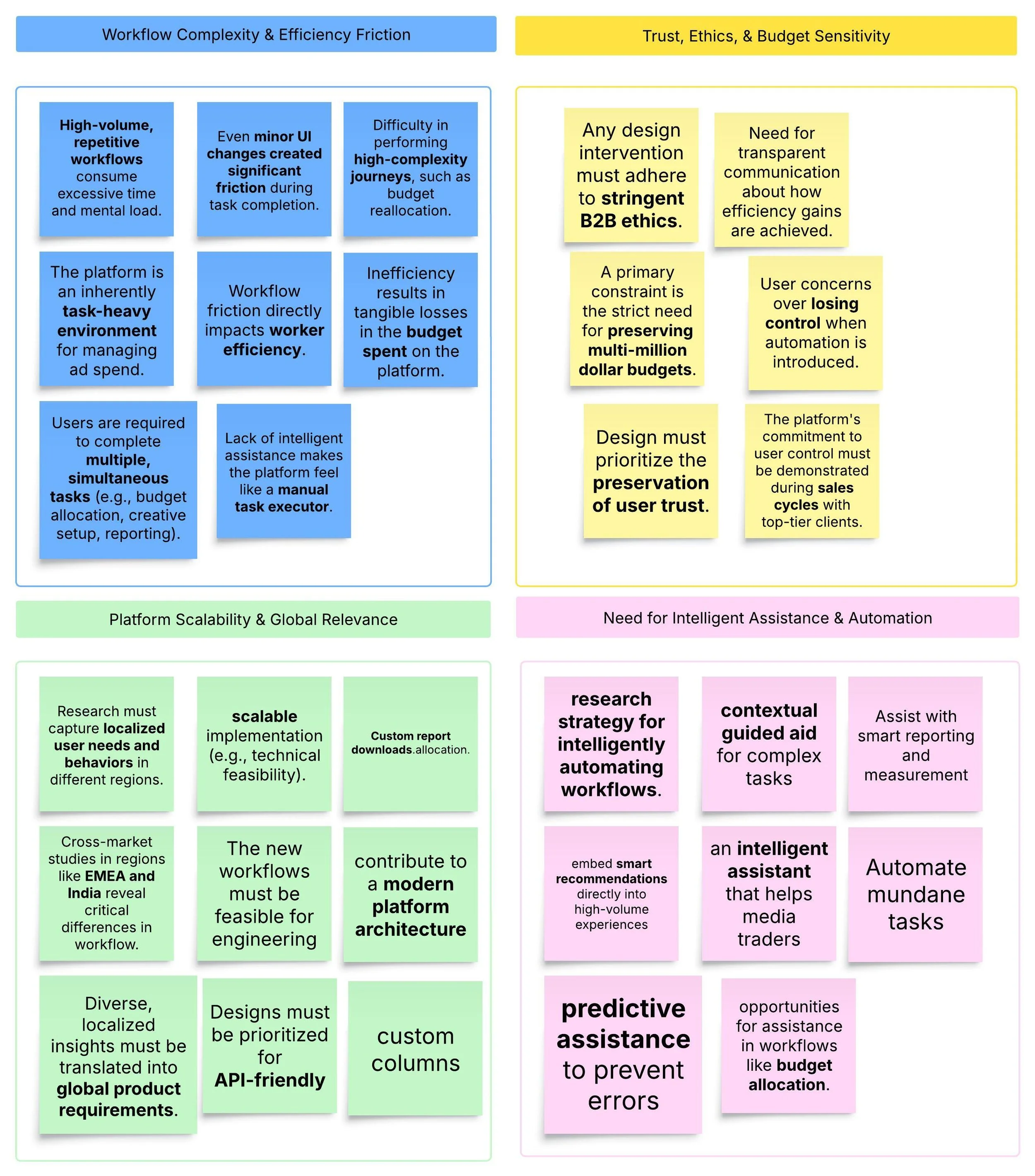Driving Automation and Serviceability for DV360's Top Tier Enterprise Clients
Challenge
Serviceability-by-Design balancing automation with necessary user control to maximize ad spend and decrease support burden. Break non-intuitiveness of the platform
Context
DV360 (Display & Video 360), a critical demand-side platform, is an inherently task-heavy environment where media traders(or advertisers) manage significant ad spend. The platform was constrained by high-volume, repetitive workflows that lacked intelligent assistance, creating a direct link between usability and efficiency.
Strategic Importance & Leadership Scope:
I spearheaded the transformation of DV360 into an automation-driven, scalable enterprise platform, partnering closely with Product and Engineering to align research with business-critical priorities. My multi-year research program identified and solved high-friction workflows, validated efficiency gains during key sales cycles, and embedded ethical research practices. The result was demonstrable increases in user satisfaction, workflow efficiency, and platform adoption, positioning DV360 as a leader in enterprise advertising automation.
Impact
Measurable increase in user efficiency and directly correlated with higher ad budget utilization on the platform (validated via CSAT benchmarking).
Successfully scoped and prioritized the API feature roadmap to address the top 20% of user workload, guaranteeing that engineering resources were focused on high-ROI automation essential for top-tier client tasks.
Leveraged localized field research (e.g., in EMEA and APAC) to translate diverse regional needs into global product requirements leading to broader product adoption.
Difficulty
The Workflow Friction: Users were required to complete multiple, simultaneous tasks (e.g., budget allocation, creative setup, reporting). Despite the straightforward nature of the tasks, even minor UI changes created significant friction, directly impacting worker efficiency and resulting in tangible losses in the budget spent on the platform.
The Automation Imperative: The product direction needed a foundational research strategy to intelligently automate workflows and assist primary users, all while operating under the strict constraints of 1) maintaining worker efficiency and 2) preserving multi-million dollar budgets.
3. Advertiser Trust: As a B2B platform managing client funds, any design intervention had to adhere to stringent B2B ethics, ensuring the preservation of user/advertiser trust and transparent communication about efficiency gains.
4. DV360 had a considerable internal usage. UX needed to provide a framework for prioritization while enabling better UX both internally and externally.
Methodology
I established and executed a multi-year research program, serving as a strategic partner to Product and Engineering to guide DV360's evolution from a launch product to an adopted, highly efficient platform.
Strategic UXR Integration: I championed and integrated UXR as a strategic, upfront function, cultivating robust, multi-year relationships with cross-functional leaders to ensure research influenced the core product direction and development roadmap.
Human-Centered Assistance: Led the serviceability research initiative to systematically identify areas where algorithmic assistance could solve common user errors and reduce reliance on expensive, direct customer support. This initiative systematically uncovered opportunities to embed smart recommendations, predictive assistance, and contextual guided aid directly into the high-volume user experience.
Trust and Efficiency Validation:
High-Complexity Journey Analysis: Focused research on high-volume, high-risk workflows (e.g., automated budget reallocation for $1M+ daily campaigns) to ensure automation to maximize hands-off efficiency. Pinpoint high-friction areas that, if fixed, would yield the largest efficiency gains using rolling studies and interviews.
Ethical UXR in Sales Cycles: Strategically leveraged UXR during sales cycles with top-tier customers to test proposed efficiency improvements, building trust and maintaining B2B ethics by demonstrating the platform's commitment to user control.
Global Market Localization: Partnered directly with international Sales and Product teams to conduct cross-market studies in regions like EMEA and India, capturing critical, localized user needs and behaviors related to trust and workflow.
Field Research(Contextual Inquiry) to emphasize persona differentiation for serviceability: Field studies generated distinct personas for internal users and external users in different markets (EMEA, APAC). The findings bought light to understand prioritization and different personas for the same product—which directly informed the design of features like Custom Columns and Reporting, providing targeted self-service options to reduce generalized support tickets.
Affinity Mapping from one of the design workshops.
Impact & Outcomes
The research translated directly into a more efficient, scalable, and trust-centered platform, maximizing user output, speed and functional depth.
Quantifiable Efficiency Increase/Optimization: Research insights led directly to the redesign of critical workflows with UI changes, resulting in a measurable increase in user efficiency and satisfaction—a direct correlation with successful budget management on the platform.
Platform Scalability: Strategically aligned research efforts to prioritize designs that were not only user-friendly but also API-friendly and scalable. This also helped in identifying which high-volume tasks for full API automation versus human-in-the-loop assistance.
Global Relevance and Adoption: Market-specific research successfully translated diverse, localized insights into global product requirements. We invested in custom features while maintaining the standards of enterprise software. E.g., custom columns, custom report downloads, reporting, etc.
Strategic Product Assistance: The work established the product's direction for automation features enabling product team to move the platform from a manual task executor to an intelligent tool that assists media traders.


